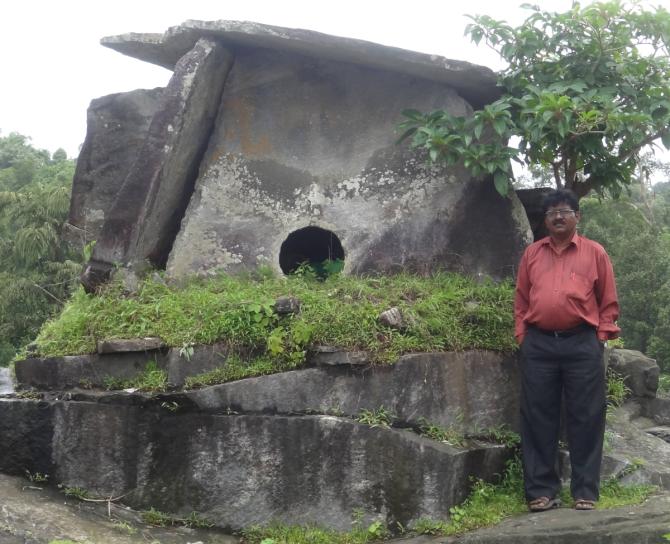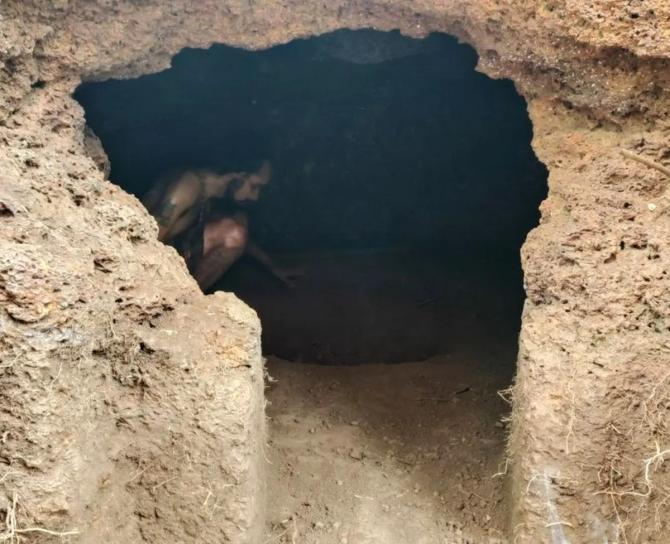 | « Back to article | Print this article |
'The Megalithic period had a significant feature. Their pottery uses black and red clay.'
'Another identifying feature is that all Megalithic burial sites are oriented towards the east.'

The Megalithic era (800 BC to 500 BC) gave south India many firsts.
Which is why the discovery of a rock-cut cave at Aturu-Kundaje in Karnataka's Dakshina Kannada district is a milestone for archaeology in the state.
The cave was discovered by a person working on a cashew plantation owned by the government. He alerted Professor T Murugeshi, head of the department of history and archaeology at MSRS College, Shirva.
The 59-year-old professor, who has been teaching for 34 years, tells Rediff.com's A Ganesh Nadar that he has personally discovered 148 burial sites from the Megalithic era.

Could you please tell our readers how you discovered this cave?
I have been working for 25 years in the field of research with my students.
The local people know this and usually inform me when they find anything.
Nishchit, a local from that area, called to tell me a cave had been discovered. I asked him to send some photos. He sent them and a video as well.
On April 9-10, I went there with my students.
It took us two days to clear the area of shrubs after which we found an engraved circle, which was about seven feet in diameter.
Below it, there was a hemispheric cave with a side opening.
In coastal Karnataka, we find that these caves and burial sites usually have a central opening.
In Kerala, these kinds of caves have central and side openings.
This one was different in that it had no central opening, only a side one.
It is a burial site.
How do you know this cave is from the Megalithic era?
On the west coast of India, in Karnataka and Kerala, there are hundreds of burial sites in rock-cut caves.
Dr A Sundar (who used to work in the department of archaeology, Karnatak University) has identified many rock-cut caves in Karnataka.
The Megalithic period had a significant feature. Their pottery uses black and red clay.
Another identifying feature is that all Megalithic burial sites are oriented towards the east.

Has the material you found in the cave been carbon dated?
Only a small quantity of pottery was available.
We did not find any iron or bones so we did not do carbon dating.
I think the local people have taken away most of the pottery.
What else did you find in the cave?
Apart from the pottery, we discovered an altar at the centre of the cave.
This is the only cave in India from that era with an altar.

Can you tell us a bit more about the burial sites from the Megalithic era?
Generally, Megalithic burial sites are found in coastal Karnataka and Kerala. They are secondary burial sites.
The corpse is burnt outside after which the ash is collected in three-legged jars that are then kept inside the rock-cut caves.
Were people living in these caves at that time?
They never lived in caves. The caves were only used for burial purposes.
Did they cultivate food grains or were they hunters?
They were farmers.
They used to store water in tanks for agricultural purposes.
They were the first in south India to follow the method of tank irrigation.
When did people stop living in caves and started building houses?
In the Megalithic era, they built and lived in mud houses.
They gave high importance to burial sites. This is peculiar to the Megalithic period.

Tell us about some of the other discoveries you have made.
I have discovered hundreds of caves. I have also discovered and recorded 148 burial sites.
Did they have their Gods or did they pray to Nature during the Megalithic era?
They had their local Gods.
Their burial sites were also prayer sites.
I have also seen figures of Mother Gods. They most probably followed the matriarchal system of society.
What is special or particular to this era?
Well, as I said earlier, they used black and red pottery. And they were the first to introduce tank irrigation in south India.
They introduced the use of iron there.
They had a political system for the first time in south India.
Feature Presentation: Rajesh Alva/Rediff.com